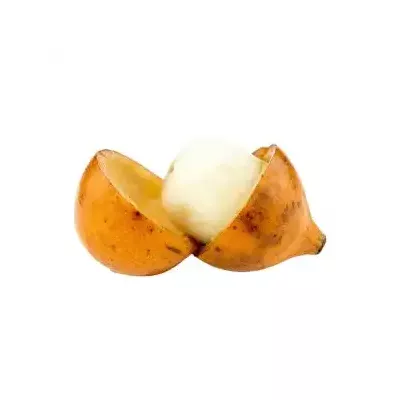



Achachairu fruit is sweet with a very distinct flavor. It has good keeping quality as well.
Achachairu is an easy to grow plant that can grow in partially shaded conditions. Hardly any maintenance is required for the plant. The tree doesn’t grow very big and is a good choice when space is a constraint.
It has as ornamental foliage and is also used for landscaping.
See Achachairu plant growth profile, care and health benefits.

Pay using UPI, Card or Netbanking

Shipping within 3 working days
Achachairu or the Achacha as it is called sometimes, is native to the Amazon forests. It is commercially cultivated in Bolivia and Australia. Due to its evergreen and symmetric canopy, it is also used for landscaping.
It is to be noted, in some regions Garcinia gardneriana is also called achachairu.
The young fruit is green, which turns into an attractive orange colour as it matures. The fruit will be still sour at this stage. It takes another couple of weeks to fully ripen, when it will turn reddish or a darker shade of orange.
When ripe, the oblong-shaped fruit has a thin peel that is easily removable. The white flesh inside is sweet, with a tinge of sourness to it. The flesh is easily separated from the seed. The fruit can remain edible for up to two weeks.
In the initial years, the plant prefers light shade as it needs to be protected from the intense midday sun. Later, it thrives in full sun and grows with very little care. It is also tolerant of light shades. Light shade is preferred at places where the intensity of the heat is high, else it may burn the foliage.
It has a very strong root system. The canopy grows symmetrically in a pyramidal shape. Like mangosteen, initial growth is very slow, typically reaching three metres or less when it reaches maturity at 6 or 7 years. However it continues to grow and may reach up to 7-8 metres.
When planted in the ground, a spacing of 7 metres is recommended.
However, it may be maintained as a small tree of 12 feet or less in height. In that case, it can manage with less spacing between the plants.
Achachairu is easy to grow, and very little care is needed once established. Achachairu prefers slightly acidic soil.
Achachairu can be grown in a large container of 100 to 150 litres.
Though grafted plants may yield more in a shorter period, seedlings from the seeds of mature plants give the best results in terms of yield and quality. It does not require separate male and female plants.
Data sheet